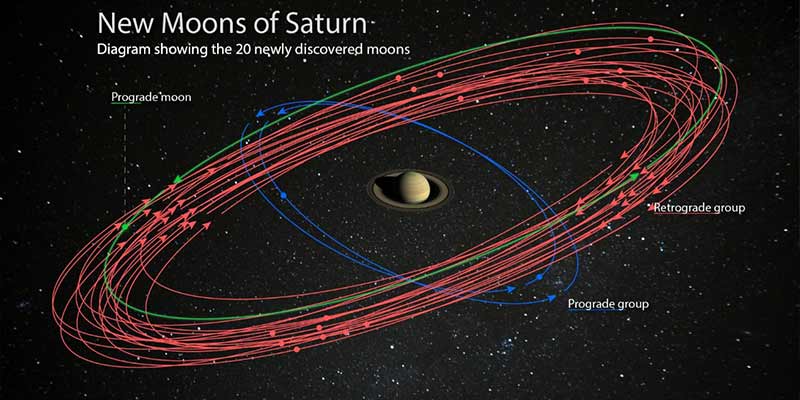- World
- Oct 09
It's official. Saturn is the king of moons
Saturn now reigns as the solar system’s ‘moon king’, thanks to 20 newfound moons. That brings the ringed planet’s total known satellites to 82, knocking Jupiter - with 79 moons - off the throne, the International Astronomical Union’s Minor Planet Center announced October 7.
Some of the specks captured in images taken from 2004 to 2007 by the Subaru Telescope in Hawaii were, in fact, moons orbiting Saturn. By comparing the objects’ locations over time, the team found that three of the newfound moons are prograde, orbiting in the same direction that Saturn rotates, while 17 are retrograde, travelling in the opposite direction. Each is between 2 and 5 km wide.
All but one of the newfound moons fall into three existing clusters of moons. Astronomers think that these groups formed when larger moons broke apart, either colliding with each other or with a passing comet. But one prograde moon is an oddball: the angle of its axis’s tilt suggests that it belongs with other similar moons that fall within a two-year orbit. But it’s farther out among the retrogrades, where it circles Saturn in three years.
Saturn
* Saturn is similar to Jupiter, although it has about one-third the mass. A day on Saturn is only 10 hours and 39 minutes long; it spins so fast that its diameter at the equator is 10 per cent larger than its diameter from pole to pole. However, its day is longer than that of Jupiter.
* Saturn has a solid core likely made of rock and ice, which is thought to be many times the mass of Earth. Covering this core is a layer of liquid metallic hydrogen, and on top of that are layers of liquid hydrogen and helium. These layers conduct strong electric currents that, in turn, generate Saturn’s powerful magnetic field.
The ring system
* The most spectacular part of Saturn is its magnificent system of planetary rings, which stretch some 300,000 km across. The ring system is divided into three main parts: the bright A and B rings and the dimmer C ring. There are many other fainter rings as well.
* The A and B rings are divided by a large gap called the Cassini Division, named after Italian astronomer Gian Domenico Cassini.
* Within the A ring itself is another division, called the Encke Gap after Johann Encke, who first found it in 1837. Although these gaps appear to be completely empty, they are nonetheless filled with tiny particles, and, in the case of the Cassini Division, dozens of tiny ringlets.
* Although Saturn’s rings measure more than 160,000 km across, they are only about 1-2 km thick. That is why they sometimes seem to disappear from view on Earth. When the orbit of Saturn is such that we see the rings edge-on, the rings look like a thin line and can be nearly invisible.
* One idea about the formation of the rings is that they were once larger moons that were destroyed, either by collisions, or by tidal interactions with Saturn’s gravity tearing them apart. The bits of moons then settled into orbit around Saturn.
Saturn’s moons
Saturn has 62 confirmed moons, and its largest moon is Titan, which is larger than Earth’s own moon and has a thick, opaque atmosphere. Also like Jupiter, many of these are small moons that are likely to be asteroids captured in Saturn’s gravitational field.
Mimas
Mimas, the victim of a huge cratering collision long ago, looks almost exactly like the fictional ‘Death Star’ space station from the movies.
Mimas has a diameter of 396 km. It is the smallest known body in the solar system that became round because of its own gravitation.
Enceladus
Enceladus was recently detected as having geysers of water shooting out from its surface, suggesting the presence of liquid water deep in its core.
Enceladus is one of only three outer solar system bodies (along with Jupiter’s moon Io and Neptune’s moon Triton) where active eruptions have been observed. The craters of Enceladus have been named Alibaba and Alladin.
Titan
Titan is the largest moon of Saturn and perhaps the most complex moon in the entire solar system. This is the only moon in the solar system with a dense atmosphere.

